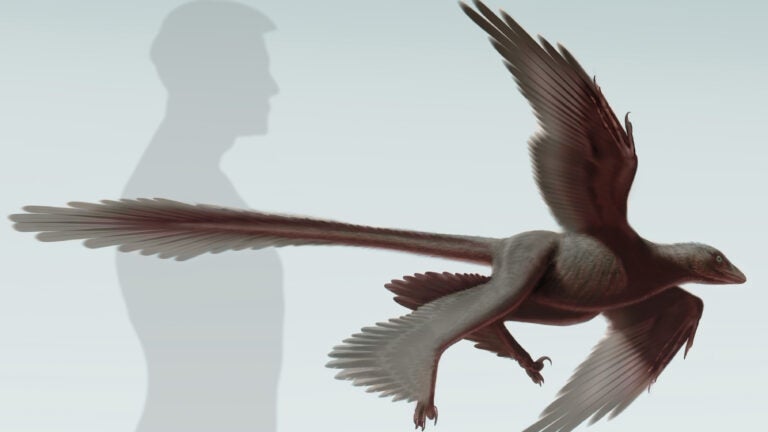
Changyuraptor yangi is considered the biggest of the four-winged dinosaurs. (Illustration by S. Abramowicz/courtesy of the Dinosaur Institute, Natural History Museum)
Feathered fossil find in China builds the case for flying dinosaurs
“At a foot in length, the amazing tail feathers of Changyuraptor are by far the longest of any feathered dinosaur”
A newly discovered raptorial dinosaur fossil with exceptionally long feathers adds to growing evidence that dinosaurs flew before birds did.
An international team of scientists from the Natural History Museum of Los Angeles County, USC and other institutions discovered the fossil in China. They assert that the fossil has a long feathered tail that was instrumental for decreasing descent speed and assuring safe landings.
National History Museum paleontologist and USC Dornsife adjunct faculty member Luis Chiappe led the team, which included Michael Habib, assistant professor of research at the Keck School of Medicine of USC. Their paper was published in Nature Communications on July 15.
Raptors with a view
The 125-million-year-old dinosaur, named Changyuraptor yangi, was found in the northeast Chinese province of Liaoning. Discoveries of feathered dinosaurs in the area have surged over the last decade. The newly discovered dinosaur sports a full set of feathers cloaking its entire body, including the extra-long tail feathers. “At a foot in length, the amazing tail feathers of Changyuraptor are by far the longest of any feathered dinosaur,” Chiappe said.
Tipping the scale at nine pounds, the four-foot-long Changyuraptor is the biggest of all “four-winged” dinosaurs. This raptor was a fully grown adult, according to analysis by University of Cape Town scientist Anusuya Chinsamy.
Changyuraptor yangi weighed nine pounds, about the size of a small domestic cat today.
The long feathers attached to both legs and arms of these ancient predators have led researchers to conclude that the four-winged dinosaurs were capable of flying. “Numerous features that we have long associated with birds in fact evolved in dinosaurs long before the first birds arrived on the scene,” said co-author Alan Turner of Stony Brook University. “This includes things such as hollow bones, nesting behavior, feathers…and possibly flight.”
Jumbo jets of the feathered dinosaur world
How well these creatures used the sky as a thoroughfare has remained controversial. The new discovery explains the role that the tail feathers played during flight control. For larger flyers, safe landings are of particular importance. “It makes sense that the largest microraptorines had especially large tail feathers — they would have needed the additional control,” said Habib, who made news in 2012 when he and Justin Hall of USC Dornsife proposed a new theory describing how four-winged dinosaurs flew.
The discovery of Changyuraptor consolidates the notion that flight preceded the origin of birds, being inherited by the latter from their dinosaurian forerunners. “The new fossil documents that dinosaur flight was not limited to very small animals but to dinosaurs of more substantial size,” Chiappe said. “Clearly far more evidence is needed to understand the nuances of dinosaur flight, but Changyuraptor is a major leap in the right direction.”
Interested in the evolution of flight? Follow Michael Habib on Twitter at @aeroevo.



